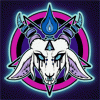
Ancient Rome meets Ancient Egypt. This was done for the wraparound cover of the conbook for Furlandia 2014.
The artwork was done with acrylic paints on 11"x17" illustration board. There is also a little metallic paint on the original that gives it some shimmer.
The original will be in the EF art show.
The artwork was done with acrylic paints on 11"x17" illustration board. There is also a little metallic paint on the original that gives it some shimmer.
The original will be in the EF art show.
Category Artwork (Traditional) / All
Species Unspecified / Any
Gender Multiple characters
Size 1200 x 779px
File Size 325.6 kB
Hm, very nice mythological and historical references you pulled to make this piece.
I'm guessing these two fellas are based off of Ceasar and Cleopatra, but... well, furrified.
Also, can't help but feel how appropriate it is that Ceaser (or at least someone who brings to mind Ceasar) is a wolf, since the whole Romulus and Remus thing.
And how you're using a cat to portray Cleopatra, likely as a reference to Bast.
I'm guessing these two fellas are based off of Ceasar and Cleopatra, but... well, furrified.
Also, can't help but feel how appropriate it is that Ceaser (or at least someone who brings to mind Ceasar) is a wolf, since the whole Romulus and Remus thing.
And how you're using a cat to portray Cleopatra, likely as a reference to Bast.
Nswt tawy and the imperator!
There's so much I love about this piece! Sekhmet and Hathor in two different styles of yoke dress with paws, hooves, and tails yet.
Also real hieroglyphic text is a rare thing in any sort of artwork. That's one tongue-twister above the Nswt's (queen's) head. Nmaanebi? (tw). Auseti makes me giggle. That could easily be a late period composite deity name. Why do the two determinatives of Auset (Isis) have pancakes on their heads? I'm just wondering.
There's so much I love about this piece! Sekhmet and Hathor in two different styles of yoke dress with paws, hooves, and tails yet.
Also real hieroglyphic text is a rare thing in any sort of artwork. That's one tongue-twister above the Nswt's (queen's) head. Nmaanebi? (tw). Auseti makes me giggle. That could easily be a late period composite deity name. Why do the two determinatives of Auset (Isis) have pancakes on their heads? I'm just wondering.
You did a very good job. You definitely got the style of the best hieroglyphic texts down. Lots of real ancient scribes weren't even a fraction as good. For example, in the Papyrus of Ani the artwork is excellent quality but the scribes who did the 'cursive hieloglyphic' text weren't nearly as good. It's barely readable in places and full of errors, omissions and misplaced text. Considering how complex the hieroglyphic version of the written language is, it's amazing it was used for so many centuries. In its time probably only a fraction of scribes could even write it, as opposed to hieratic which is a bit simpler and much easier to write with a brush. For modern people who are used to alphabetic written languages it's about as unfamiliar as any writing system can be.
Well - to be fair, Kacey has access to better art materials than the scribes did...
...and does anyone know whether or not the scribes were expected to supply their own ink??? Caligraphists and Scriveners (legal copyists) had to do that for centuries, and the expense and/or labor might might have affected quality.
...and does anyone know whether or not the scribes were expected to supply their own ink??? Caligraphists and Scriveners (legal copyists) had to do that for centuries, and the expense and/or labor might might have affected quality.
I'm not sure if that's even known. There were plenty of expensive pigments used in royal tombs. Elsewhere most everything was written in black and red with very simple pigment. Even 'Egyptian blue' was used mainly in expensive tomb paintings. Modern pigments are definitely easier to use than ancient ones. It's really amazing how easy writing became in the course of the 20th century.
Heh, considering that by the time Rome rolled up, the Pharaohs were Greek...
Cleopatra: And I find what you're wearing most becoming. Greek, isn't it?
Antony: I have a fondness for almost all Greek things.
Cleopatra: As an almost all-Greek thing, I'm flattered.
Ah, the nexus between Greece and Egypt. The ancient Greeks noted that Egyptian history already went back thousands of years. The Greeks copied and altered many Egyptian forms, but they carved palm fronds onto Greek temples, a strictly Egyptian influence.
Cleopatra: And I find what you're wearing most becoming. Greek, isn't it?
Antony: I have a fondness for almost all Greek things.
Cleopatra: As an almost all-Greek thing, I'm flattered.
Ah, the nexus between Greece and Egypt. The ancient Greeks noted that Egyptian history already went back thousands of years. The Greeks copied and altered many Egyptian forms, but they carved palm fronds onto Greek temples, a strictly Egyptian influence.
The original is 11"x17", and I did the mosaic with fluid acrylics. I used a small brush to draw the grout between the tiles on the white sections, and on the darker sections I painted in each tile leaving space around it, and then I did various washes over each section to unify them.

 FA+
FA+











































































Comments